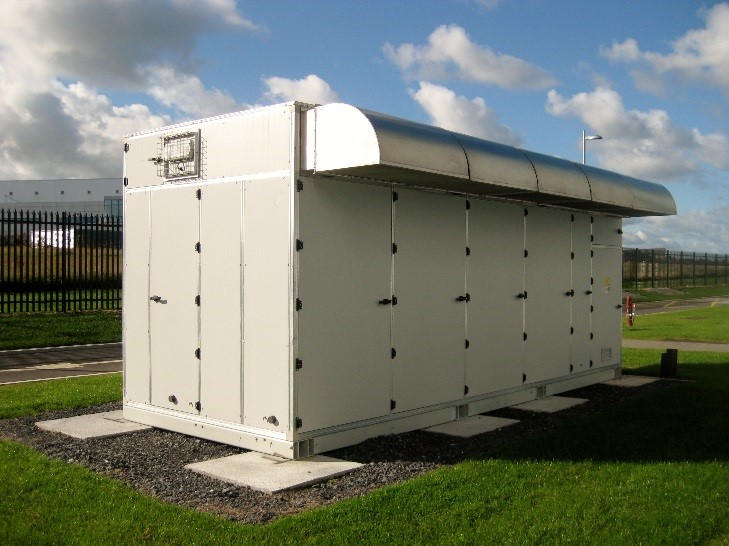Microsoft’s ITPAC – A Perfect Fit for Off-the-Grid Computing Capacity
 Sean James, Senior Research Program Manager
Sean James, Senior Research Program Manager
Global Foundation Services
Last November we announced our zero carbon Data Plant R&D project in Cheyenne, Wyoming. For a quick refresher, we're placing a small container data center we call an IT Pre-Assembled Component, or ITPAC, at a wastewater treatment facility in Cheyenne. A natural bi-product of a wastewater plant is methane gas, which is typically flared off because it's uneconomical to recover and convert to grid energy. At our Data Plant, we view this methane gas as an opportunity to provide a reliable power source to power a data center, and we decided to launch this project to test the concept and the capabilities.
 |
| A single ITPAC similar to this will be used atthe Microsoft Data Plant project in Cheyenne. |
Resembling a smaller cargo shipping container, ITPAC's are currently being used in many of our Generation 4 data centers to efficiently combine compute, power, cooling, and networking in self-contained modules. You might wonder how temperatures as low as 20-below zero would affect the functionality of an ITPAC and the servers inside. The answer, it doesn't. They are pre-manufactured with a recycled steel shell that will protect the hundreds of servers inside it from the harsh Wyoming climate. On cold days, say below 50 Fahrenheit, a portion of the hot exhaust air from the servers is redirected internally through a mixing unit on top of the ITPAC where it mixes and warms the air to a temperature suitable for the servers. On hot days, the ITPAC can pull outside air in to help cool the servers. For these reasons, the ITPAC is perfectly suited for the Data Plant project.
Energy is one of the most abundant resources on this planet. The challenge is how to access and make it more readily available. Microsoft looks at over 35 criteria when selecting a site to build a data center, including the latency between the users in that area and our existing data centers, quality of the end-to-end customer experience, close proximity to dark fiber, suitable environmental factors including permits, average temps that enable free cooling, completed studies showing local risk factors, and no endangered species, and sufficient land size. These modular data center designs allow us the flexibility needed to deploy near naturally-occurring energy opportunities that large, monolithic data centers cannot. In addition to faster build times, the use of modular infrastructure designs like the ITPAC allow us to build or add only the capacity we need based on the given energy sources and the services being delivered.
How do our modular data centers enable sustainable energy? An ITPAC can be deployed at a provisional source of energy and re-deployed elsewhere, once that source is exhausted; such as at a landfill. Landfills have a half-life of about 15 years and once the buried organics have been exhausted the methane output drops quickly. Our ITPAC has been engineered to be deployable in a wide range of environmental conditions and has been tested in many climates from arid to humid including our data center in Boydton, Virginia and the United Nations in Nairobi, Kenya. Modular data centers have been operating in the extreme temperature ranges of our own data centers such as Quincy, Washington and soon to be, the Wyoming plains.
Segmenting a large data center into smaller modular building blocks also helps improve service availability while improving the user experience. Most servers have a redundant array of inexpensive disks (RAID). Copying the data to multiple disks increases the read speed while removing a single point of failure. A redundant array of inexpensive data centers gets the data close to the user while minimizing latency, decentralizing the application, and eliminating a single point of failure. Uninterruptible Power Supplies (UPSs), generators, redundant infrastructure can all be eliminated and provide a significantly reduced carbon footprint and making the ITPACs more energy efficient.
Wherever you find dense populations of people you will also find a large demand for online services and, in addition, sources of biogas. Biogas is the natural byproduct of decomposing organics found in all forms of waste. Biogas is limited in its usefulness due to its high composition of CO2, as high as 50 percent in some cases as opposed to natural gas which contains essentially zero. The fuel cell technology used in our biogas data plant actually consumes CO2 in the electrolytic process making it well suited for biogas.
ITPACs enable not only limited sources of energy like methane produced from a wastewater plant, but also abundant sources such as large power plants. The modular nature allows data centers to be installed at existing power plants with minimal impact to the site. Most power plant operators are skittish about excavating near their 200 megawatt plant, but are much more comfortable to explore setting up a preassembled data center on a pad of crushed rock or precast slab. The modular nature of the fuel cell also minimizes the impact to existing plants; a very critical issue when contemplating installation at sources of energy near mission critical infrastructures. Bringing large demand applications like those hosted in data centers today within the property line of a power plant and/or off the grid is not only more reliable, but electrically efficient and reduces congestion on an already overly congested grid.
The Data Plant pilot in Wyoming demonstrates the attributes of Microsoft's modular designs for data centers today, including the fact that they can also be remotely monitored and unmanned.
In our own data centers, we are seeing PUEs coming in below 1.2 and water consumption is down 90 percent compared to traditional industry facilities, delivering significant improvements in total cost of ownership (TCO) and reducing our impact on domestic and industrial water supplies. In addition, these ITPACs help lower waste by reducing packaging and shipping materials, and associated transport carbons used to ship individual servers and equipment.
How are we progressing with the Data Plant project today? We're currently preparing to begin construction at the site and will start producing renewable power for the data plant later this year. We'll be sure to provide more updates about the project at a later date.
We're proud of the innovations we've made in researching, building and operating data centers. And we'll continue pursuing advancements as we respond to the evolving challenges of cloud computing. While our advancements are competitive advantages to Microsoft's cloud service offerings, we hope they will help others make the cloud a more efficient and reliable place that public and private organizations and individual consumers can trust. If you'd like to know more about our data center sustainability efforts, please read our recent 10 Earth-Friendly Facts about Microsoft's Cloud Infrastructure blog and visit our Datacenter Sustainability page for whitepapers, videos and strategy briefs.
- Sean James, Senior Research Program Manager, Datacenter Advanced Development